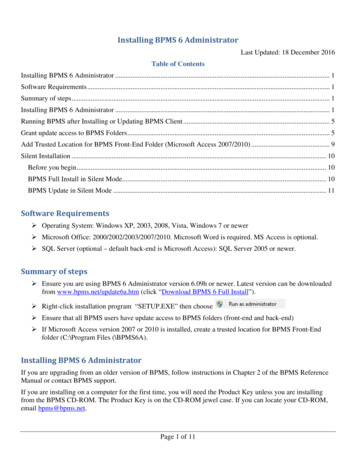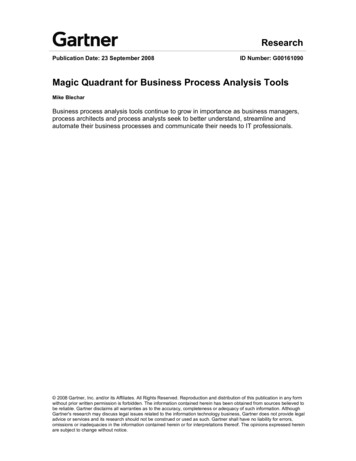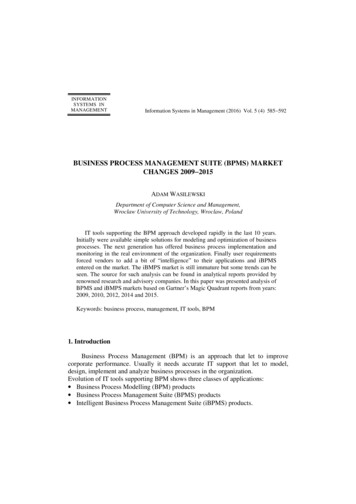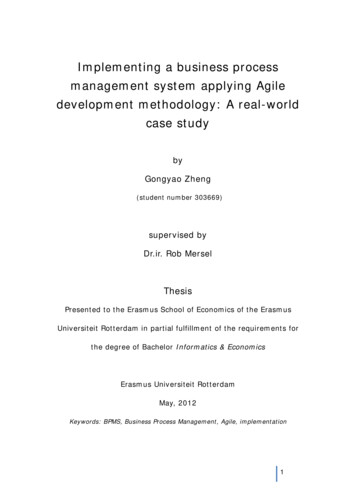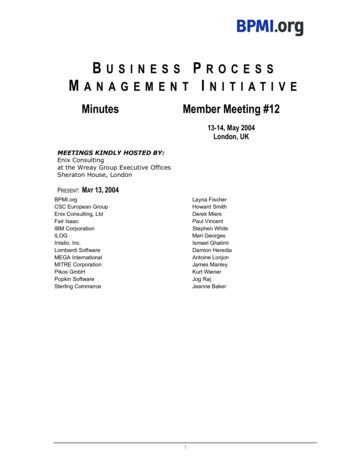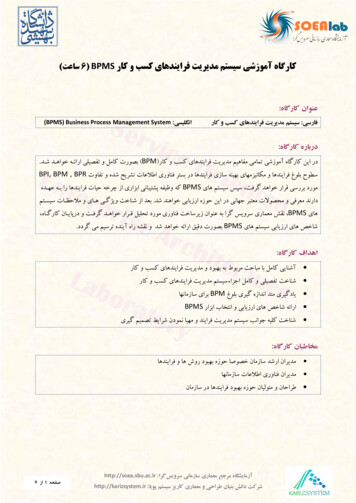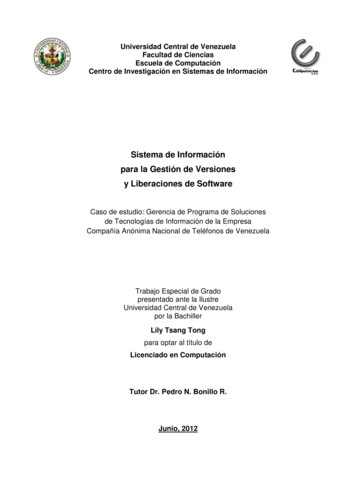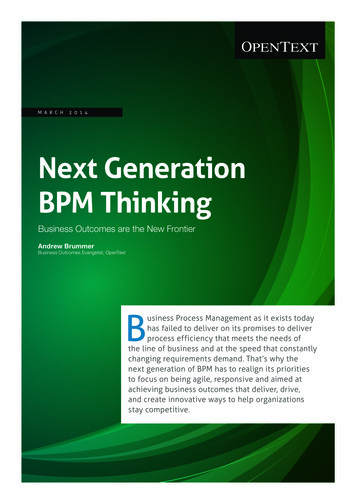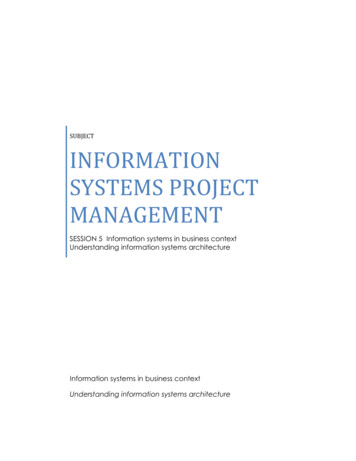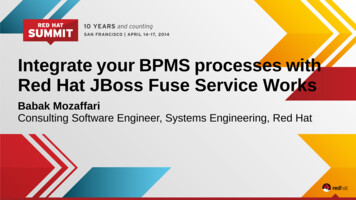
Transcription
Integrate your BPMS processes withRed Hat JBoss Fuse Service WorksBabak MozaffariConsulting Software Engineer, Systems Engineering, Red Hat
Red Hat JBoss BPM SuiteAn overview of Red Hat JBoss BPM Suite 6.0
Business ProcessWhat is a business process? A defined set of business activities that represents the stepsrequired to achieve a business objective. It includes the flow and use of information and resources. Typically involves both machine and human interactions,integrates with various internal and external systems, andincludes both static and dynamic flows that are subject to bothbusiness rules and technical constraints.
Business Process Management Business process management is a systematic approach todefining, executing, managing and refining business processes. BPMN (Business Process Model and Notation) 2.0 is a popularstandard for business process management.
BPMN 2.0 The primary goal of BPMN is to provide a notation that is readilyunderstandable by all business users, from the business analyststhat create the initial drafts of the processes, to the technicaldevelopers responsible for implementing the technology that willperform those processes, and finally, to the business people whowill manage and monitor those processes. Thus, BPMN creates a standardized bridge for the gap betweenthe business process design and process implementation.
Red Hat JBoss BPM Suite 6 BPMS 6 is an open source BPM suite that combines businessprocess management and business rules management, enablingbusiness and IT users to create, manage, validate, and deploybusiness processes and rules. BPMS 6 provides advanced business process managementcapabilities compliant with the widely adopted BPMN 2.0standard.
Red Hat JBoss BPM Suite 6 BPMS 6 comes with a choice of modeling tools; it includes abusiness-user-friendly, web- based authoring environment as wellas an Eclipse plugin for developers, to enable all projectstakeholders to collaborate effectively and build sophisticatedprocess and decision-automation solutions. The inclusion of Red Hat JBoss Business Rules ManagementSystem (BRMS) adds seamless integration with business rulesand complex event processing functions to ease the developmentand facilitate the maintenance of processes in the face of rapidlychanging requirements.
Red Hat JBoss BPM Suite 6 Business activity monitoring (BAM) and process dashboardsprovide invaluable information to help manage processes. Process simulation helps refine business processes by enablingtheir analysis and assessment of the dynamic behavior ofprocesses over time. Red Hat JBoss BRMS and Red Hat JBoss BPMS use acentralized repository where all resources are stored. Thisensures consistency, transparency, and the ability to audit acrossthe business.
Red Hat JBoss Fuse Service WorksAn overview of Red Hat JBoss Fuse Service Works 6.0
Red Hat JBoss Fuse Service Works It is a platform for developing enterprise application integration(EAI) and service-oriented architecture (SOA) solutions. It consists of a service component framework, businessrules/complex event processing, life-cycle governance, runtimegovernance and process automation. It is built on the same core as JBoss Fuse with enterprisemessaging, Camel and CXF Users can use it to design, deploy, integrate and orchestratebusiness services.
Enterprise Application Integration (EAI) Defined by Wikipedia as an integration framework composed of acollection of technologies and services which form a middlewareto enable integration of systems and applications across theenterprise.
EAI with JBoss Fuse Service Works The versatile Enterprise Integration Pattern (EIP) framework isimplemented in routing and transformation processes for fasterand more efficient integration solutions. A high performance messaging broker supports messagingpatterns such as publish-subscribe, point-to-point and storeforward, and multiple cross language clients. Service development using the web services framework, whichexposes integration assets as services and calls externalservices, supporting all major web services standards. It alsosupports RESTful calls.
Service-Oriented Architecture (SOA) Defined by OASIS as a paradigm for organizing and utilizingdistributed capabilities that may be under the control of differentownership domains. It provides a uniform means to offer,discover, interact with and use capabilities to produce desiredeffects consistent with measurable preconditions andexpectations.
SOA with JBoss Fuse Service Works A high performance messaging broker supports messagingpatterns such as publish-subscribe, point-to-point and storeforward, and multiple cross language clients. Service development using the web services framework, whichexposes integration assets as services and calls externalservices, supporting all major web services standards. It alsosupports RESTful calls. Structured service development through a lightweightframework that provides full lifecycle support for developing,deploying, and managing service-based applications.
SOA with JBoss Fuse Service Works The capability of an automated registry with workflow to allowyou to manage the lifecycle of services from design, developmentand deployment by defining, exposing and enforcing rules orpolicies. Business transaction monitoring to capture service activityinformation, define and collect metrics, and define alerts andSLAs.
Red Hat JBoss BPM SuiteFeatures and Capabilities of BPM Suite 6.0
BPM Suite Example Application Application developed entirely within the web process designer. Sample mortgage application processing. Uses various BPMS features including data modeler, rules, taskand process forms, user tasks, web service task, decisiongateways, swimlanes and so on. Released alongside the BPMS Reference Architecture anddocumented in detail. Released alongside the produce in the Customer Support Portal.
Business Central - Repositories BPMS uses asset repositories (knowledge stores) that containprojects. Each asset repository uses a Git repository to store its data. Business Central provides a front-end to allow users to managethese repositories and their content. Business Central allows access to the Git repositories through theGit and SSH protocols. Pushing content back is only possiblethrough SSH for security.
Business Central - Projects Each BPMS repository contains one or multiple projects. BPMS projects are Maven projects. Each BPMS Maven project may depend on another Mavenproject or act as a dependency of other projects. Maven project object models (pom) or JAR files for a BPMSproject may be accessed through REST calls.
Graphical Data Modeler The BPMS web designer includes a web-based custom graphicaldata modeler that is accessed from the Tools menu. The data modeler allows Java classes to be created and modifiedwithout require Java development expertise Drop-downs and fields are presented to create new types, fieldsand composite objects. User-friendly labels can be set for classesand their field names. Classes created by the data modeler are regular Java Beans withannotations added.
Process Design Business processes can be created with either the web processdesigner or the eclipse-based tooling. The web process designer links to and automatically opensrelated tools, such as the form designer and the data modeler. The web process designer is specially ideal for non-developerswho do not routinely use a Java IDE. The web tooling allows processes to be started, input variables tobe set and even test data to be provided.
User Tasks A User Task represents a piece of work the given user can claimand perform. It allows human interaction to be modeled in abusiness process. A User Task can be assigned to a particular actor, multiple actors,or to a group of actors. If assigned to multiple actors or a group ofactors, it is visible in the Task Lists of all the actors and any of thepossible actors can claim the task and execute it. Tasks can have any number of input and output variables thatmapped from or to the variables of the parent business process.
Process and User Task Forms Processes can be started through a custom form where initialvalues may be provided for some or all process variables. User tasks may be viewed, claimed and completed throughBusiness Central, in which case, task forms are used to displaythe input variables and obtain the values of the output variablesfrom the user. Both process and user task forms are designed and edited withthe form designer in Business Central. The form designer supports mapping fields to object graphs.
Business Rules Red Hat JBoss BPM Suite 6 comes with integrated Red HatJBoss BRMS 6. Various formats and tools are available for rules, including but notlimited to technical rules, guided business rules, decision tables,domain specific languages and so on. Processes can incorporate rules by using a Business Rule Taskthat evaluates a number of specified rules based on availabledata.
Swimlanes and Business Continuity Assigning tasks to groups has the advantage of avoiding tightcoupling between individuals and business processes that mayneed attention outside that individual's working hours In this model, any member of a group of users is able to view allassigned tasks and claim a task to work on. Swimlanes allow a task to be assigned to a group, but to undergoassignment a single time for each business process instance. Once a task in a swimlane has been claimed by an actor, all otherinstances of the same task or other tasks in the same swimlanewill automatically be assigned to that same actor.
Service Tasks The pluggable implementation allows users to create variouscustom and service tasks that may be reusable and even madeavailable in the palette with a distinct custom icon. For convenience, Log, Email, REST and Web Service tasks havebeen provided out of the box. For example, to use the Web Service Task, provide the requireddata mapping between process variables to the serviceparameter and from the service result, and provide the servicelocation details.
Error Handling Business errors can be thought of as error conditions that arisefrom invalid input data or unexpected results. Errors like these arebest handled in the process design by using decision gatewaysand user tasks to take the necessary manual steps. Calling a web service introduces new risks. The external servicemay be down and nonfunctional for unexpected reasons. Variouscommunication, network and server errors may result in an invalidresponse. An intermediate error catching event can redirect the processthrough a special flow to handle a technical error.
Process Simulation Business process simulation is a valuable analytic instrument forthe purpose of assessing the behavior of business processesover time. This can help estimate the number of external calls, plan forhuman resources to handle the user tasks and otherwise assist insizing and estimating technical and business requirements. The web process designer can show all the possible processpaths, as calculated for a process. The number of paths dependson the number of decision points and the potential complexity ofthe process.
Running Process Simulation Before running process simulation, various simulation propertiesneed to be set up for the process. This includes a probabilityvalue for each sequence flow that leaves a diverging gateway. Other simulation properties include the cost of executing a nodeper time unit, the minimum and maximum processing time that'senvisioned for a node and how it may be distributed. For user tasks, staff availability and the number of working hoursalso effect process simulation. Simulation runs a number of processes at the given pace.
Business Activity Monitoring The Dashbuilder application included in BPM Suite 6 allows thecreation of reports, panels, pages and entire workspaces for thepurpose of business activity monitoring. The BPMS database is set up as a source of data by default butother external data sources may also be defined and added. A dashboard called jBPM is preconfigured with sample reports onBPMS processes and tasks; it queries the BPMS database. New reports can be created based on the BPMS database or incombination with other business data sources.
Red Hat JBoss Fuse Service WorksFeatures and Capabilities of Fuse Service Works 6.0
Fuse Service Works Capabilities Enterprise Service Bus (ESB) Service delivery Service governance Business transaction monitoring
Enterprise Service BusFuse Service Works includes an ESB, consisting of: Apache Camel, to provide a modern enterprise integrationpattern-based development model Apache ActiveMQ, as a high-performance messaging broker Apache CXF, a web services framework
Service delivery Fuse Service Works provides full life cycle support for developing,deploying and managing service-oriented applications This is provided by SwitchYard, a lightweight service deliveryframework, based on Service Component Architecture (SCA) SwitchYard supports distributed and cross-functional teams withcode and model-driven tooling, and enables developers to focuson the actual business logic by separating the underlyingimplementation
Service governanceLife cycle management for services, from design and developmentthrough deployment, is based on the Overlord project, helping todefine, expose and enforce rules or policies.
Business transaction monitoringOverlord also provides the infrastructure to capture service activityinformation and then provides necessary metrics and alerts to helpmeet business and service level agreements (SLAs) and optimizethe integration solutions.
SCA Assembly Model Service Component Architecture (SCA) provides a programmingmodel for building applications and solutions based on a ServiceOriented Architecture (SOA). SCA provides a model for the composition of services andcreation of service components. In the SCA Assembly Model, SCA Domain includes compositeswhich contain assemblies of service components and theconnections and related artifacts, which describe how they arelinked together.
Composite A composite is displayed as a light blue rectangle and representsthe boundary between what is inside and what is outside anapplication. A SwitchYard application consists of exactly one composite thathas a name and a targetNamespace. The target namespace value qualifies a name and makes itunique within a SwitchYard runtime.
ComponentA component is a modular container for application logic andconsists of the following: Zero or one component service definitions Zero to many component reference definitions One implementation, which is the actual logic for providing orconsuming services
Component ImplementationSwitchYard provides multiple implementation options including: Bean, where a CDI Bean is used to provide a service or consumeother services using annotations Camel, EIP-style routing and service composition using the XMLor Java DSL in Apache Camel BPMN 2, service orchestration and human task integrationexpressed as BPMN 2 and executed using jBPM BPEL, web service orchestration using the OASIS standard Rules, decision services based on Drools
Component Service Used to expose the implementation as a service Java interface, WSDL, or ESB interface (named data types) Can only be invoked by components in the same application Promoted to a composite service to be exposed externally
Composite Service Represents a service that is visible to other applications Can only be realized by promoting a component service May have an interface that is different from the componentservice May require transformation to and from the type of the componentservice interface
Service Binding Used to define an access method for a composite service Multiple bindings may allow a single service to be accessed indifferent ways Typically represents a protocol or transport adapter such asSOAP, JMS, and REST The SCA binding is an exception, which allows services acrossapplications in the same runtime to be wired together in memory
Component Reference Allows a component to consume other services May consume a service offered by another component in thesame application May leverage a composite reference to consume a serviceoutside the application
Composite Reference Allows a component reference to be wired to a service outside theapplication Reference bindings are used with composite references to specifythe communication method for invoking the external service Available reference bindings are are the same as service bindings There can only be one binding for each composite reference
FSW / BPMS IntegrationIntegration Fuse Service Works and BPM Suite
Fuse Service Works – Integration Capabilities As an integration platform, various protocols are supported Out of the box support for multiple inbound protocols Out of the box support for multiple outbound protocols Extensible to support new integration methods
BPM Suite – Outbound Integration Capabilities Out of the box service tasks: WS Task for SOAP / HTTP calls REST Task for JSON / HTTP calls REST Task for XML / HTTP calls Custom development: Synchronous and Asynchronous custom service tasks Implement the WorkItemHandler interface Add icon and make new task available in service task palette
BPM Suite – Web Service Task Simply drag and drop WS task from the palette Configure the task based on the Web Service WSDL: Url: WSDL URL Namespace: WSDL target namespace Interface: service name Mode: SYNC or ASYNC Operation: WSDL operation
BPM Suite – Web Service Task In DataInputSet, set correct Parameter type for Web Service In DataOutputSet, set correct Result type for Web Service In Assignments: Map to Parameter from a process variable or a constant Map from Result to a process variable
BPM Suite – REST Task Simply drag and drop REST task from the palette Configure the task based on the service: Url: service location Method: HTTP method, may be GET, POST, PUT and DELETE REST services that use the GET and DELETE methods do notexpect a message and react to the URL
BPM Suite – REST Task REST services that use the POST and PUT methods typicallyrequire the following two DataInputSet items added: ContentType: For example, application/json or application/xml Content: the actual message content
BPM Suite – REST Task The service response is return in String form as a DataOutputSetitem called Result. This can be mapped to a process variable ReadTimeout and ConnectTimeout provide further fine tuning ofthe http (Apache HttpClient) behavior
BPM Suite – REST Task By default, the REST Task is not configured to authenticate The REST Task may be reconfigured for security by editing thework item handler configuration file within Business Central: nf This file configures the public default constructor of the RESTwork item handler: "Rest": new ()
BPM Suite – REST Task You may set up your environment to use a different constructor. To use Basic Authentication, use the constructor that takes theusername and password: "Rest": new (“myID”, “myPassword”) To use Form-based Authentication, use the constructor that takes theusername and password: "Rest": new (“myID”, “myPassword”, “http://local/passwd”)
BPM Suite – REST Task Configuring the username, password or in the case of form-basedauthentication, the authentication URL in the property file affectsall instances of all your processes that use the task. These values will be ignored and replaced by equivalentDataInputSet variables which may in turn be set to constantvalues in the process, or mapped from a process variable: Username Password AuthUrl
BPM Suite – Inbound Integration Capabilities BPMS provides a REST API out of the box for incoming calls Individual application components accept slightly differentimplementations of this REST API: Knowledge Store REST API: to manage the content Deployment REST API: to deploy or undeploy kieModule jar files Runtime REST API: calls to the Execution Server and the ProcessExecution Engine, Task Execution Engine, and Business Rule Engine.They allow you to request and manipulate runtime data.
BPM Suite – Runtime REST API Runtime REST API calls include: Simple process calls Simple task calls History calls Command executions
BPM Suite – Runtime REST API All calls are synchronous and return JAXB objects Except the Execute calls, all other REST calls can either useJAXB or JSON To use JSON, the JSON media type ("application/json") should beadded to the ACCEPT header Parameters are defined as query string parameters for GET calls To pass a Map parameter, you can submit key-value pairs to theoperation using a query parameter prefixed with the keywordmap keyword, e.g. ?map age 5000
BPM Suite – Simple Process CallsThese are simple GET or POST calls that accept either JSON orXML. Examples include: Start a process instance (accepts query map parameters): POST /runtime/{deploymentId}/process/{procDefID}/start Return process instance details: GET anceID} Signal process instance (accepts query map parameters): POST anceID}/signal
BPM Suite – Simple Task CallsThese are simple GET or POST calls that accept either JSON orXML. Examples include: List task summary data: GET /task/query Retrieve task content in JAXB XML form: GET /task/content/{contentID} Complete task (accepts query map parameters): POST /task/{taskID}/complete
BPM Suite – History CallsThese are simple GET or POST calls that accept either JSON orXML. Examples include: Return all logs of process instance: GET anceID} Return variables of process instance: GET anceID}/variable Return logs of all process instances: GET /runtime/{deploymentId}/history/instance
BPM Suite – Command Execution Available through both REST and JMS API Advanced usage, including batch execution Only accepts XML (representing JAXB Command classes) Client API helps create and send commands
BPM Suite – REST Client API Use the appropriate remote factory: ry Factory Obtain the abstract RuntimeEngine from the factory, for example:String applicationContext "http://localhost:8080/business-central";String deploymentId "com.redhat.bpms.examples:mortgage:1";URL jbpmURL new URL( applicationContext );RemoteRestRuntimeFactory remoteRestSessionFactory new RemoteRestRuntimeFactory( deploymentId, jbpmURL, userId, password );RuntimeEngine runtimeEngine remoteRestSessionFactory.newRuntimeEngine();
BPM Suite – REST Client API The transport will be transparent to the client code in the followingsteps Get the KIE Session and call the required APIKieSession kieSession runtimeEngine.getKieSession();Map String, Object processVariables new HashMap String, Object ();Application application new Application();application.setDownPayment( 100000 );processVariables.put( "application", application );String processId tion";kieSession.startProcess( processId, processVariables );
BPM Suite – Command Execution Client API The Client API can also help with command execution:JaxbCommandsRequest jaxbCommandsRequest new ymentId( deploymentId );List Command ? commands new ArrayList Command ? ();StartProcessCommand startProcessCommand new ssId( processId );startProcessCommand.setParameters( processVariables );commands.add( startProcessCommand );jaxbCommandsRequest.setCommands( commands );String xmlRequest new JaxbSerializationProvider().serialize( jaxbCommandsRequest );
Calling BPMS from FSW Given native BPMN support, some of the BPM Suite libraries areavailable in Fuse Service Works Fuse Service Works is missing some BPMS libraries, notablythose used for remote access and client API Fuse Service Works will provide better support for remote calls toBPM Suite in later releases As a practical matter, the use of BPMS libraries from the FSW 6.0environment to make remote calls is challenging
Calling BPMS from FSW To avoid the challenges and library conflicts in FSW 6.0, it'seasiest to use simple Java, including DOM and JAXB libraries,and basic libraries such as Apache HTTP Client and RESTEasy The goal is to produce the request in simple XML and use HTTPPOST to send the request to BPMS When using custom classes in the request (e.g., processvariables), these custom classes must be serialized to XML Third-party libraries may help serialize custom classes that arenot JAXB compliant
Serializing JavaBeans classes to XML Using only JDK libraries to parse JavaBeans:BeanInfo beanInfo Introspector.getBeanInfo( bean.getClass() );for( PropertyDescriptor descriptor : beanInfo.getPropertyDescriptors() ){String fieldName descriptor.getName();if( "class".equals( fieldName ) ){continue;}Object value descriptor.getReadMethod().invoke( bean, new Object[] {} );if( value ! null ){Element child document.createElement( fieldName );element.appendChild( child );if( isPrimitiveOrWrapper( descriptor.getPropertyType() ) )child.setTextContent( value.toString() );elseaddBeanProperties( child, value );
Serializing JavaBeans classes to XML Recursion can be used to serialize nested JavaBeans The top-level object is mapped to a value element value xsi:type "application" xmlns:xsi "http://www.w3.org/2001/XMLSchema-instance" amortization 30 /amortization applicant income 100000 /income name Amy /name ssn 333224449 /ssn /applicant downPayment 100000 /downPayment property address 12301 Wilshire /address price 500000 /price /property /value
Generating command-request XML The request can be created with the primitive DOM library The request XML document has the same consistent wrapper:DocumentBuilderFactory documentBuilderFactory erFactory.setNamespaceAware( true );Document document ument();Element commandRequest document.createElement( "command-request" );Element deploymentIdNode document.createElement( "deployment-id" );deploymentIdNode.setTextContent( deploymentId );commandRequest.appendChild( deploymentIdNode );Element ver document.createElement( "ver" );ver.setTextContent( "1" );commandRequest.appendChild( ver );
Generating start-process XML The start-process request is an element inside command-request When starting a process, the initial process variable values arepassed as a parameter withing the requestElement commandRequest getCommandRequest( deploymentId, processId );Element startProcess commandRequest.getOwnerDocument().createElement( "start-process" );startProcess.setAttribute( "processId", processId );commandRequest.appendChild( startProcess );addParameters( startProcess, params );
Adding parameters The process variable is provided as an item within a parameterDocument document command.getOwnerDocument();Element parameterElement document.createElement( "parameter" );command.appendChild( parameterElement );for( Entry String, Object entry : params.entrySet() ){String beanName entry.getKey();Object beanObject entry.getValue();Element item document.createElement( "item" );item.setAttribute( "key", beanName );parameterElement.appendChild( item );Element value document.createElement( "value" );value.setAttributeNS( "http://www.w3.org/2001/XMLSchema-instance", "xsi:type", beanName );item.appendChild( value );addBeanProperties( value, beanObject );}return parameterElement;
Start Process XML request ?xml version "1.0" encoding "UTF-8"? command-request deployment-id com.redhat.bpms.examples:mortgage:1 /deployment-id ver 1 /ver start-process processId tion" parameter item key "application" value xsi:type "application" xmlns:xsi "http://www.w3.org/2001/XMLSchema-instance" amortization 30 /amortization applicant income 100000 /income name Amy /name ssn 333224449 /ssn /applicant downPayment 100000 /downPayment property address 12301 Wilshire /address price 500000 /price /property /value /item /parameter /start-process /command-request
Creating a RESTEasy ClientRequest Given application URL and credentials, create a ClientRequest Apache HTTP Client must provide preemptive authenticationBasicHttpContext localContext new BasicHttpContext();HttpClient preemptiveAuthClient createPreemptiveAuthHttpClient( userId, password, 5, localContext );ClientExecutor clientExecutor new ApacheHttpClient4Executor( preemptiveAuthClient, localContext );ClientRequestFactory requestFactory new ClientRequestFactory( clientExecutor, new URI( applicationContext ) );return requestFactory.createRelativeRequest( relativeURL );
HTTP Client with Preemptive AuthenticationBasicHttpParams params new onTimeout( params, timeout * 1000 );HttpConnectionParams.setSoTimeout( params, timeout * 1000 );DefaultHttpClient client new DefaultHttpClient( params );if( userName ! null && !"".equals( userName ) ){client.getCredentialsProvider(
Business activity monitoring (BAM) and process dashboards provide invaluable information to help manage processes. Process simulation helps refine business processes by enabling their analysis and assessment of the dynamic behavior of processes over time. Red Hat JBoss BRMS and Red Hat JBoss BPMS use a
